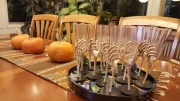The past year of spreading COVID-19 left many people in the United States and around the world with emotional and economic challenges. If you need something to lift your spirit and interrupt negative thoughts, an art project might be the answer. Decades of research reveal creative activities decrease blood pressure, improve memory, and lower stress.
 You don’t have to be a painter or sculptor. The healing power of art comes in many forms; numerous activities produce health benefits. If you are interested in painting, but not sure what to paint, visit your local art center for ideas or check out YouTube art tutorials. Take a class in the
You don’t have to be a painter or sculptor. The healing power of art comes in many forms; numerous activities produce health benefits. If you are interested in painting, but not sure what to paint, visit your local art center for ideas or check out YouTube art tutorials. Take a class in the  comfort of your home. If you are not the painting type, consider other art forms. How about singing or learning to play an instrument? Do you have a guitar or some other instrument lying dormant? Dust it off and reteach yourself to make a little music.
comfort of your home. If you are not the painting type, consider other art forms. How about singing or learning to play an instrument? Do you have a guitar or some other instrument lying dormant? Dust it off and reteach yourself to make a little music.
Writing prose and poetry, gardening or nurturing house plants – all can improve emotional health and well-being.
Exercise is an important component in stress reduction and health, take a walk and bring a camera. If you are up with the birds, share the experience by taking photographs of the ever-changing sunrise each morning. If you like to sleep in, take sunset photos on your evening walk.


In The Healing Power of Art, an article written by art therapist Megan Carleton at Massachusetts General Hospital, she stated, “Once people engage, they often realize they are having fun and the time passes faster.” If your days seem long, an art project can provide a positive distraction and a connection with family members or friends.
You don’t have to be in the same room to create and share art. Five women, three Lipstick Logic sisters and two of our friends living thousands of miles apart, in Minnesota, Montana, and Hawaii, are creating art together. The pandemic has kept us apart physically but close in spirit via the internet.
While talking to each other we realized we were in a slump and needed a good challenge to jump start our energy to get us over the pandemic finish line. Knowing we each loved art, we came up with the 2021 plan called “An Artsy Challenge.” We will share a piece of art at the end of each month.
Why not join us?
Call a few friends or create art projects with your kids. Come up with your own Artsy Challenge for the year ahead. Knitting, baking, mosaics, paint by number, creating with clay – the list goes on. Any new endeavor has the power to shift a person’s mind and energy in a positive direction. Having others join your group will help you stay committed and connected. Creating something new is inspiring and transformative. Heal yourself through artistic expression.
has the power to shift a person’s mind and energy in a positive direction. Having others join your group will help you stay committed and connected. Creating something new is inspiring and transformative. Heal yourself through artistic expression.
We would love to learn about or see your finished projects. And we all hope your happiness factor improves by simply adding art and camaraderie to your life.
Betty, Bev, Brenda, Christina and Chieko /Lipstick Logic Artsy Challenge Members


 October’s crisp autumn air and brilliant forest colors quicken our thoughts and actions to prepare, as nature does, for the shortened hours of sunlight – the “dark side of the year.”
October’s crisp autumn air and brilliant forest colors quicken our thoughts and actions to prepare, as nature does, for the shortened hours of sunlight – the “dark side of the year.” As a grandmother, I’ve experienced this transition many times. Preparation comes in many forms and has evolved as did ancient customs.
As a grandmother, I’ve experienced this transition many times. Preparation comes in many forms and has evolved as did ancient customs.

 They believed it a time when barriers were breachable between the physical world and denizens of the underworld. Celtic Druid priests set circular bonfires (to represent the sun) while the Celts wore costumes to scare off ghosts.
They believed it a time when barriers were breachable between the physical world and denizens of the underworld. Celtic Druid priests set circular bonfires (to represent the sun) while the Celts wore costumes to scare off ghosts. marked “Halloween” from storage. I decorate our home with the delightful contents. Each item evokes memories of years past, even to the scents and joys of childhood.
marked “Halloween” from storage. I decorate our home with the delightful contents. Each item evokes memories of years past, even to the scents and joys of childhood. moons, stars, and witch hats for the classrooms of each of my sisters and me. When the awaited day arrived, the afternoon of the school day commenced with students dressing in their costumes for the elementary school parade. We marched throughout the halls and classrooms admiring the creativity of our efforts. We returned to our rooms for a party of treats and laughter. We knew this was not even the end of day’s fun.
moons, stars, and witch hats for the classrooms of each of my sisters and me. When the awaited day arrived, the afternoon of the school day commenced with students dressing in their costumes for the elementary school parade. We marched throughout the halls and classrooms admiring the creativity of our efforts. We returned to our rooms for a party of treats and laughter. We knew this was not even the end of day’s fun. movie. We’d walk to the theater around 11:00 pm to begin our night of terror with the entertainment of Boris Karloff and Bela
movie. We’d walk to the theater around 11:00 pm to begin our night of terror with the entertainment of Boris Karloff and Bela  Lugosi. Some of the more deviant souls of the crowd would leave early to lunge at us from behind hedges as we passed on our walk home. This would send us on a dead run, breathless until we were behind our locked door. Now living in another small town, with our own children grown and off to greater endeavors, I delight in seeing the ghouls, goblins, angels, butterflies, mini SWAT team members, witches, minions and others that come to our home to trick-or-treat. We have approximately three hundred and fifty each year.
Lugosi. Some of the more deviant souls of the crowd would leave early to lunge at us from behind hedges as we passed on our walk home. This would send us on a dead run, breathless until we were behind our locked door. Now living in another small town, with our own children grown and off to greater endeavors, I delight in seeing the ghouls, goblins, angels, butterflies, mini SWAT team members, witches, minions and others that come to our home to trick-or-treat. We have approximately three hundred and fifty each year.







 some bright colors to the picture by including humor, and your picture begins to lighten up. Allen Klein
some bright colors to the picture by including humor, and your picture begins to lighten up. Allen Klein






